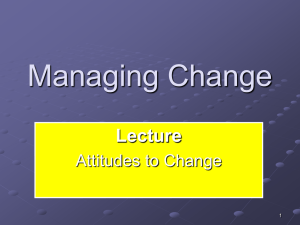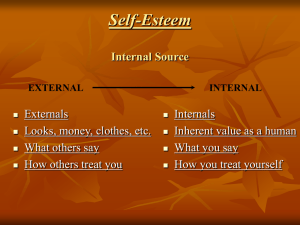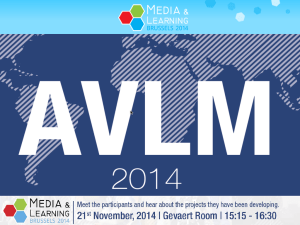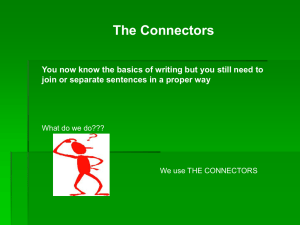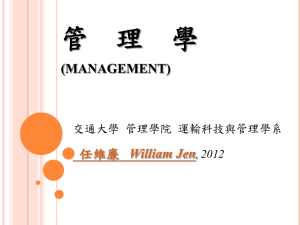Self-Assessment_10
advertisement
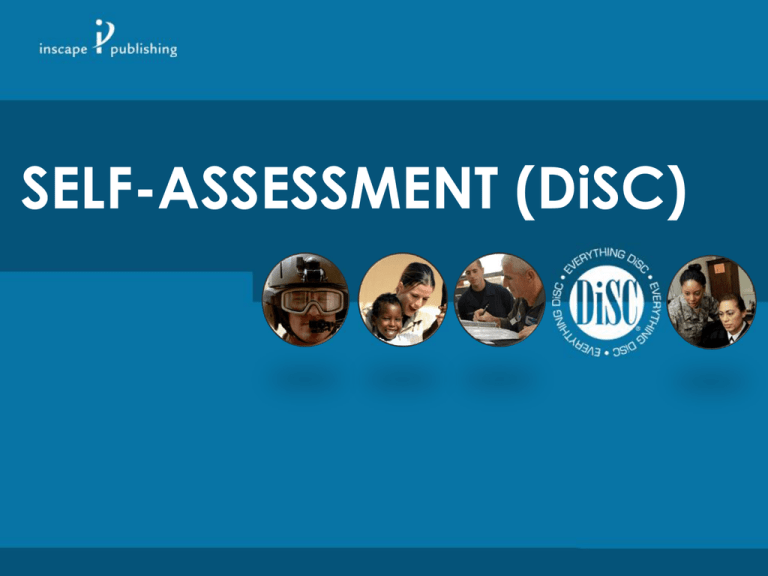
SELF-ASSESSMENT (DiSC) Overview Objectives of DiSC Four Dimensions of Behavior Letting DiSC Work for You Objectives of DiSC Become aware of your behavioral strengths as you relate to others Identify the potential contribution your strengths bring to relationships and teams Become aware that the behavioral strengths of others may be different from your own Learn what you can do to communicate better with people whose strengths are different from your own THE FOUR DIMENSIONS OF BEHAVIOR DOMINANCE INFLUENCE STEADINESS CONSCIENTIOUSNESS DOMINANCE DOMINANCE Focuses on shaping the environment by overcoming opposition to accomplish results TENDENCIES: • Wants to get results • Likes “do it and do it now” • Wants to be in charge • Likes new opportunities and challenges • Wants opportunity for advancement • Likes initiating change and taking risk • Wants wide scope of operations DOMINANCE Focuses on shaping the environment by overcoming opposition to accomplish results DISLIKES/AVOIDS: • Losing control over the environment • Being taken advantage of • Appearing weak or soft • Boredom • Being tied to routine DOMINANCE Focuses on shaping the environment by overcoming opposition to accomplish results OVERUSES: • Change for the sake of doing something new • Creating challenges • Moving people and situations around his/her favor DOMINANCE Focuses on shaping the environment by overcoming opposition to accomplish results RELATING TO “D” BEHAVIOR: • Make communication brief and to the point • Respect their need for autonomy • Be clear about rules and expectations • Let them initiate • Show your competence and independence • Stick to the topic • Eliminate time-wasters DOMINANCE Focuses on shaping the environment by overcoming opposition to accomplish results STRATEGIES FOR SUCCESS: • Develop greater awareness of the needs of others • Develop more patience with other people • Learn to negotiate with others • Participate more with others INFLUENCE INFLUENCE Focuses on shaping the environment by influencing or persuading others TENDENCIES: • Wants to be involved with people • Wants to have fun while getting things done • Likes to help people talk things out • Wants freedom from responsibility for following through on details INFLUENCE Focuses on shaping the environment by overcoming opposition to accomplish results DISLIKES/AVOIDS: • Being blamed for things going wrong • Having people be upset with him/her • Not being liked • Public humiliation INFLUENCE Focuses on shaping the environment by overcoming opposition to accomplish results OVERUSES: • Humor, playfulness • Emotional outbursts • Verbalizing thoughts and feelings • Meetings, discussions INFLUENCE Focuses on shaping the environment by overcoming opposition to accomplish results RELATING TO “I” BEHAVIOR: • Approach them informally • Be relaxed and sociable • Let them verbalize thoughts and feelings • Keep the conversation light • Provide written details • Give public recognition for accomplishments • Use humor INFLUENCE Focuses on shaping the environment by overcoming opposition to accomplish results STRATEGIES FOR SUCCESS: • Become more objective in making decisions • Develop more organized approaches to task • Improve follow-through by paying attention to key details • Learn to be direct and firm when confronting others • Gain more control over use of time STEADINESS STEADINESS Focuses on cooperating with others to carry tasks TENDENCIES: • Likes to be involved with people • Wants everyone to do their share • Likes things to run smoothly • Wants stability and security • Wants conflict-free environment STEADINESS Focuses on shaping the environment by overcoming opposition to accomplish results DISLIKES/AVOIDS: • Situations where nobody knows what is happening • Confusion and instability • Lack of clarity on expectations • Situations requiring aggressive confrontations STEADINESS Focuses on shaping the environment by overcoming opposition to accomplish results OVERUSES: • Accommodation to others • Modesty • Predictability STEADINESS Focuses on shaping the environment by overcoming opposition to accomplish results RELATING TO “S” BEHAVIOR: • Be logical and systematic in your approach • Provide a consistent and secure environment • Let them know how things will be done • Use sincere appreciation • Show their importance to the organization • Let them adapt slowly to change STEADINESS Focuses on shaping the environment by overcoming opposition to accomplish results STRATEGIES FOR SUCCESS: • Learn to handle change better • Become more assertive • Increase comfort with handling conflict • Vary routines occasionally • Become more receptive to short-cut methods • Speak up when concerned or upset CONSCIENTIOUSNESS CONSCIENTIOUSNESS Focuses on working conscientiously with existing circumstances to ensure quality and accuracy TENDENCIES: • Wants specific criteria for performance • Likes accuracy • Likes setting and meeting high standards • Wants opportunities to analyze and assess • Likes logical, systematic approaches to work CONSCIENTIOUSNESS Focuses on shaping the environment by overcoming opposition to accomplish results DISLIKES/AVOIDS: • Personal criticism - Both unjustified and justified • Spontaneous displays of feelings • Changes and surprises that may affect his/her performance • Situations that require talking about his/her personal life CONSCIENTIOUSNESS Focuses on shaping the environment by overcoming opposition to accomplish results OVERUSES: • Analysis • Criticism of performance - Both of self and others • Defensiveness when questioned about his/her performance • Logical approaches to people and situations CONSCIENTIOUSNESS Focuses on shaping the environment by overcoming opposition to accomplish results RELATING TO “C” BEHAVIOR: • Give clear expectations and deadlines • Show dependability • Demonstrate loyalty • Be tactful and emotionally reserved • Be precise and focused • Value high standards CONSCIENTIOUSNESS Focuses on shaping the environment by overcoming opposition to accomplish results STRATEGIES FOR SUCCESS: • Develop more comfort with emotionally charged situations • Determine potential payoff before investing time analyzing • Learn to value informal interactions with others • Adjust standards to the needs of the environment • Practice confronting directly rather than making indirect comments LETTING DiSC WORK FOR YOU Putting it all together Motivating and helping others Assigning tasks to match subordinates’ strengths Assembling teams of complementary strengths and weaknesses Needs others to Dominance Influence Calculate risks Create a predictable environment Recognize the needs of others Speak directly Develop systematic approaches Prefer to deal with things instead of people Steadiness Apply pressure on others Help to prioritize work Are flexible in work procedures Conscientiousness Compromise with the opposition State unpopular positions Encourage teamwork Summary Objectives of DiSC Four Dimensions of Behavior Letting DiSC Work for You
